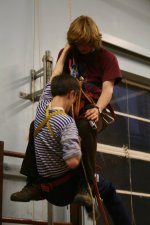I can't find any details on the Danish incident, but being military it may have been a parachute harness, or back mounted attachment, both of which means you hang forwards when unconscious and compromise your breathing. Ascending kit holds you more upright than descending, but at least your head can loll back to keep your airway open (a narrow rift, or being against a wall, may prevent this).
I am moderately confident that the Danish incident is one reported by Madsen et al "Tolerance to Head-up Tilt and Suspension With Elevated Legs" Aviation, Space and Environmental Medicine, Vol. 69, No. 8, pp781-784. August 1998 and cited as Reference 2 by Seddon. I purchased a copy of the paper being curious and it states:
During first aid training, a 25-yr-old soldier was suspended from a wall with a strop around his thorax in order to simulate hanging. He was left unobserved for approximately 6 rain and was subsequently found lifeless and taken down. A physician arrived after an additional 6 min; he diagnosed the soldier with cardiac arrest and initiated cardiopulmonary resuscitation with success. On admission to the emergency unit the soldier was in sinus rhythm (
that is normal heart rhythm). However, he soon developed ventricular fibrillation (
that is a malfunction of the normal rhythm), and despite DC-conversion (
that is a treatment aimed at correcting the rhythm), he never regained consciousness and died with signs of ischemic brain damage (
an injury that results from impaired blood flow to the brain). The patient was without signs of strangulation (no bursted conjunctival capillaries
(in the eyelids), no marks on the neck), and he did not suffer from any disease prior to the incident, nor was he taking any medication.
Items in italics are my additions.
 www.ncbi.nlm.nih.gov
www.ncbi.nlm.nih.gov




